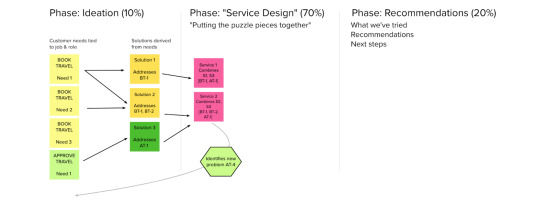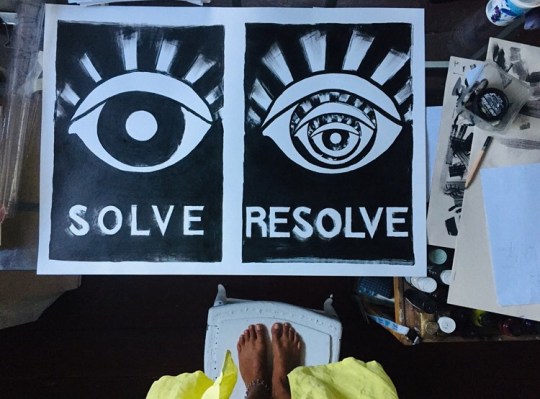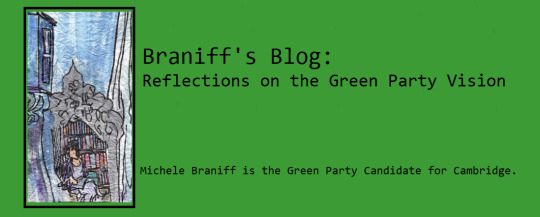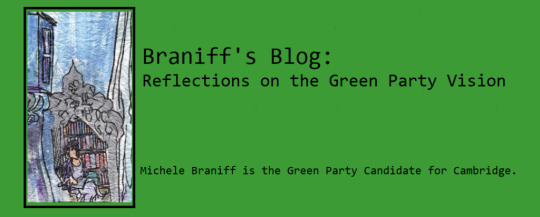#wickedproblem
Explore tagged Tumblr posts
Text

Another example of a wicked design problem is our healthcare system. As we look at our healthcare options, cost, and accessibility, it's clear this isn't a tame problem, as described in our reading (Rittel 1972). There are so many layers to the healthcare system, from who benefits, to how much should be accessible to all at low or no cost. This is something that still could use some problem solving as we navigate the current healthcare and insurance landscape.
Image credit: Getty Images
2 notes
·
View notes
Link
UX Design or User Experience Design "is both an ideology and a process; it's all about solving complex problems in a user-centric way. Design Thinking was created as a way of taking the processes and approaches that designers use and applying them to problems that designers don't typically encounter." youtube.com/watch?v=Tvu34s8iMZw
0 notes
Text
No Easy Fix for Wicked Problems

As I move forward in my career, the main thing that I would like to carry forward is that wicked problems can be unfixable. For my project, I originally wanted to tackle gentrification but that was too broad of a subject so I had to find a way to focus in on one part of the issue. Gentrification is definitely a wicked problem, and it is too big for just me to fix, but I can work on fixing one part of the problem. For my final project, I chose to tackle enhancing communication in DC’s gentrified communities. I chose this subject because one thing that I’ve noticed from living in DC is that residents are blaming each other for gentrification and displacement, when really it is so much bigger than residents but it is lawmakers and large corporations that are contributing to this issue.
0 notes
Text
Syria: A Wicked Problem

The Syrian civil war meets all of the criteria of a wicked problem. The issues surrounding it are complex and there are many competing foreign policy interests at stake for the United States. Because of this, there are many different opinions on how it should be solved. On one hand, people believe that we should immediately pull out of the war but that would immediately leave us vulnerable to the rebuilding of ISIS and other terrorist groups. The other option being to stay there and fight with no real solution to end the way and at the risk of more American lives being lost. With the war ongoing with no end in sight, it difficult to measure what a successful end would look like.
0 notes
Text
Housing Crisis loopy, some reflections
Rachel introduced this crafty tool “Loopy” and I had a quick play with it, you can see the result here: https://bit.ly/2PsqwFM
I was listening to this interview yesterday on RNZ and this made me think of the various factors that we often don’t see (iceberg) behind why the house prices in NZ and particularly in Auckland are so crazy: https://www.rnz.co.nz/national/programmes/ninetonoon/audio/2018785728/housing-crisis-tip-of-the-iceberg-report
Essentially, compared to other similar cities in Oz, US, UK, the prices in Auckland are absolutely ridiculous, more so considering the average income levels. Leonard Hong mentioned some factors in that chat that can be better visualised through something like Loopy: the decreasing fertility rates in Aotearoa, the decreasing “household occupancy” (with divorces and other factors essentially every year houses have fewer dwellers), immigration rates including now in the Covid-19 pandemic, etc.
Naturally, this Loopy is but a caricature of the problem, but even a 5-minute “sketch” starts to indicate how many visible and invisible factors are at play, and how they variations change (or don’t) the effects on other variables.
A handy tool to play with that I will start recommending as people read materials such as Jon Kolko’s https://www.wickedproblems.com/
It does make me think:
1. What other everyday problems are systemic in nature and how we only see their symptoms without paying attention to hidden variables
2. How could I use Loopy to teach basic Computational Thinking ideas to children?
3. Visual models and especially dynamic visual models that are interactive can be confusing at first but really help us think
4. The UI of Loopy is also worth analysing, the tools and the actions to create and edit elements, colour palette, etc.
1 note
·
View note
Text
Week 5: Approaching a Complex System
July 22 - 26, 2019
Joining the NextGEN Travel Program has been exciting, as well as a little daunting. We don't have a single, neat problem statement to address. This is a complex system with a lot to consider. Four different user roles, seven distinct jobs, with nuances associated with different departments, activities and of course individual needs and preferences.
One of the questions we've been grappling with is where to start. We have a lot of ground to cover, and every decision means we're choosing to exclude or not to consider something else.
I had proposed we think through each distinct Job to be Done as a separate investigation, with an eye on considering the overall service experience. However, we quickly saw the potential shortcomings; were we at risk to run out of time and not consider all the parts of the experience?
The fundamental tension, as with most projects, is depth vs breadth.
Do we focus on specific touchpoints in the existing customer journey on which we can have a huge positive impact, or go broad to ensure we have an end-to-end service to deliver?
I'd been thinking we would first go deep and then tie the pieces together, but after a team discussion, I realized the value in first ensuring we had an MVP experience (sorry buzzword police!) and then honing in on particular aspects of the service.
You've seen the sketch of the path from skateboard to bike to car? I actually prefer this one:

The purpose is to build pieces that fit together to enable you to complete the desired action, rather than spending time on interim solutions that aren't really 'the end result'.
Applying This in Practice
Rather than doing investigation sprints on each distinct Job (research, ideation, prototype, test), we are going to upfront the ideation across the different parts of the overall service. The team has already done a lot of research across the entire customer journey and identified a lot of pain points and opportunities.
Needs > Solutions > Services
Each Job has stages, with needs associated with each stage.
Each customer need can lend itself to different solutions to address said need.
Each service consists of a number of solutions linked together.

We've been calling it the "choose your own adventure" approach, where we can then stress test various services through customer engagement to identify weaknesses and even possibly uncover new customer needs.
By testing services upfront rather than individual Jobs within the overall experience, we're giving ourselves more time to surface blind-spots or gaps across the service.
Phew! It’s a daunting task, but we have a way forward. We look forward to engaging with public servants as we continue down this path to get feedback and improve our work.
Until next time! Andrea, UX Fellow
1 note
·
View note
Photo

Just a Summary of Wicked Problems.
Source: CMU Transition Design, Irwin & Kossoff based on Rittle & Webber 1973)
3 notes
·
View notes
Photo

This is actually from 8 years ago (memory of a memory 😂) But is still true. #WickedProblems #WickedMusical #Fiyeraba #WizardOfOz https://www.instagram.com/p/Bo-nrUHn7ocsSjBhQypzQOc5j_cYF_A1HhBDfI0/?utm_source=ig_tumblr_share&igshid=19f1hsc25xix8
6 notes
·
View notes
Text
Algorithms Oppression
A very impactful reading. Even though the author focused mostly on racial oppression, I couldn't help but thinking of the sexualization of the google search. “school girls” vs that of “school boys”. Those creating theese algorithms have their own biases. The problem fundamentally is not with the concept of these algorithms. It’s flawed. Does this wicked problem have a solution?
0 notes
Photo

Co-authoring with Rajesh Kasturirangan, "The Messenger" is a weekly graphic zine to illustrate wicked problems and the wicked minds needed to solve them. Check out edition#1. For more details and context on the images please visit the newsletter @ www.theMessenger.space
0 notes
Text
GCD unit 1 project
Wicked problems: Empathy
Empathy is what we have to search for on this 3 week project. On the following weeks I’ll be posting some sketchbook notes + research, discussions or possible ways of expressing what empathy means to me.
0 notes
Photo

Wicked Problems with Joanne Stone S3 E11 Agile World News Better English with our hosts Cynthia Kahn and Steve Moubray talk with “Wicked” Joanne Stone and how’s she’s applying Agility to Wicked Problems. From the moon to vaccines, learn how Wicked Problems are whipped into shape by unleashing Wicked Teams to create Wicked Solutions. Wicked Problems are gnarly issues, which can’t be solved by one person alone, have many solutions and many symptoms (for example, Covid, Climate, Poverty …). They are complex and need a sensing, iterative and adaptive approach. The same approach that we as Agilists have applied to our teams and organizations for a generation. Who is “Wicked” Joanne Stone? She wants to solve Wicked Problems www.agile-world.news #AgileWorld #AgileTalkShow #Agile https://bit.ly/2Wkj6YN
#agilecoach#agiletransformation#agileworld#agileworldnews#agileworldnewsbetterenglish#businessagility#cynthiakahn#joannestone#stevemoubray#wickedproblems#wickedsolutions
0 notes
Photo

Prompted by ‘Blink’, a book that wonderful @estbest01 gave me to read when I saw her last, I m back pondering about our conscious decision making skills and intuition. So here are my round toes and ‘Wicked Problems, Wicked Possibilities’- the originals for an animated giff which instagram doesn’t like much alas, based on poster art and the infinite need to solve and resolve the just solved resolution, adapt, change. Start again. You solve one problem and another arises, you solve a problem for one and in doing so, create a problem for Simeón else. Yet all these impossible complexity allows for broader understanding of shifting perspectives- not just others but also our own- and interconnectedness if you allow yourself to see it. The piece also included a closed eye, as means to reflect in that we all have a blind spot. We blink and I see and just imagine if the entire world had changed in that brief second. It can all change in that blink of an eye. The work was part of a webinar with fantastic designers and artists from the RaM research group @soad_brighton @slucym @ben_peppiatt which I was lucky to take part in last summer. It s all perpetually changing. My grandfather used to say ‘only fools don’t ever change their mind’. Happy Sunday! #wickedproblems #wickedproblemsolving #cybernetics #sustainabledesign #art #posterart #perpetualshifting #interconnectedness #systemsthinking #blackandwhite #ink #diseñosustentable #arte #blink #intheblinkofaneye https://www.instagram.com/p/COqstX5Ha2-/?igshid=1rkcoyyq0vcy7
#wickedproblems#wickedproblemsolving#cybernetics#sustainabledesign#art#posterart#perpetualshifting#interconnectedness#systemsthinking#blackandwhite#ink#diseñosustentable#arte#blink#intheblinkofaneye
0 notes
Text
Don’t Mute DC

If you've stayed current on different things happening in DC then you should’ve heard about the #DontMuteDC protests. To give a quick summary, someone who lives in new condos across from the MetroPCS on 7th and Florida Ave NW called and complained to T-Mobile that the Go-Go music that this location plays is loud and obnoxious, which resulted in T-Mobile telling them to get rid of the music. This store has been playing the Go-Go music out loud since the 90s, and this sudden issue shows how gentrification is affecting the city. Gentrification is a wicked problem, and luckily residents in this area are not willing to go down without a fight. A petition on change.org has gotten over 80,000 signatures in support of the store being able to continue playing their music. Also there have been peaceful protests in front of the store and up U-Street, where local residents are playing Go-Go music out loud and gathering large crowds. T-Mobile has since apologized and said that the store can continue to play their music as long as they find a happy medium with residents.
0 notes
Text
Braniff's Blog
Braniff’s Blog


The Wicked Question of Right and Left
How can the Canadian Parliament provide progressive social policies which safeguard the environment, provide a social safety net for our most vulnerable citizens and keep Canadians healthy and safer while maintaining sound fiscal policies and a resilient economy?
Politics often slips into labels about left and right and this approach can be divisive and…
View On WordPress
#braniff#braniffsblog#Cambridge#cambridgegreens#cbridgegreens#forwardtogether#michelebraniff#socialinnovation#wickedproblems#wickedquestion
0 notes
Text

Visual Diary 2 continued
This photo shows a major wicked design problem of over crowding, which leads to damaging the environment. The fragile ecosystem associated with the Chesapeake Bay is just starting to rebound due to decreased runoff and stricter rules, which all tie into design leadership.
0 notes